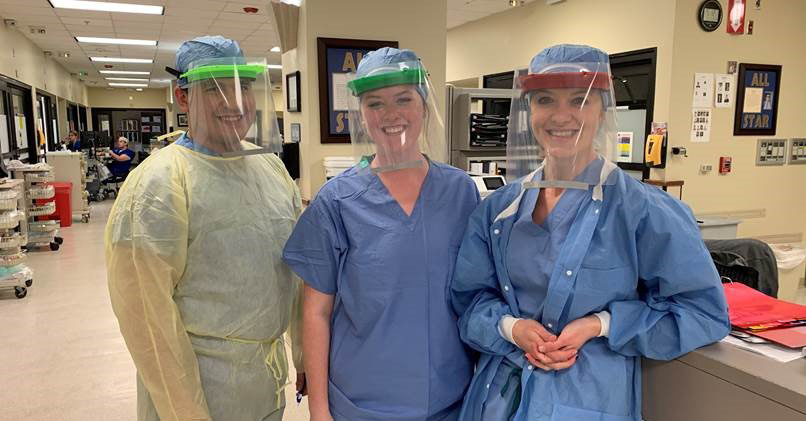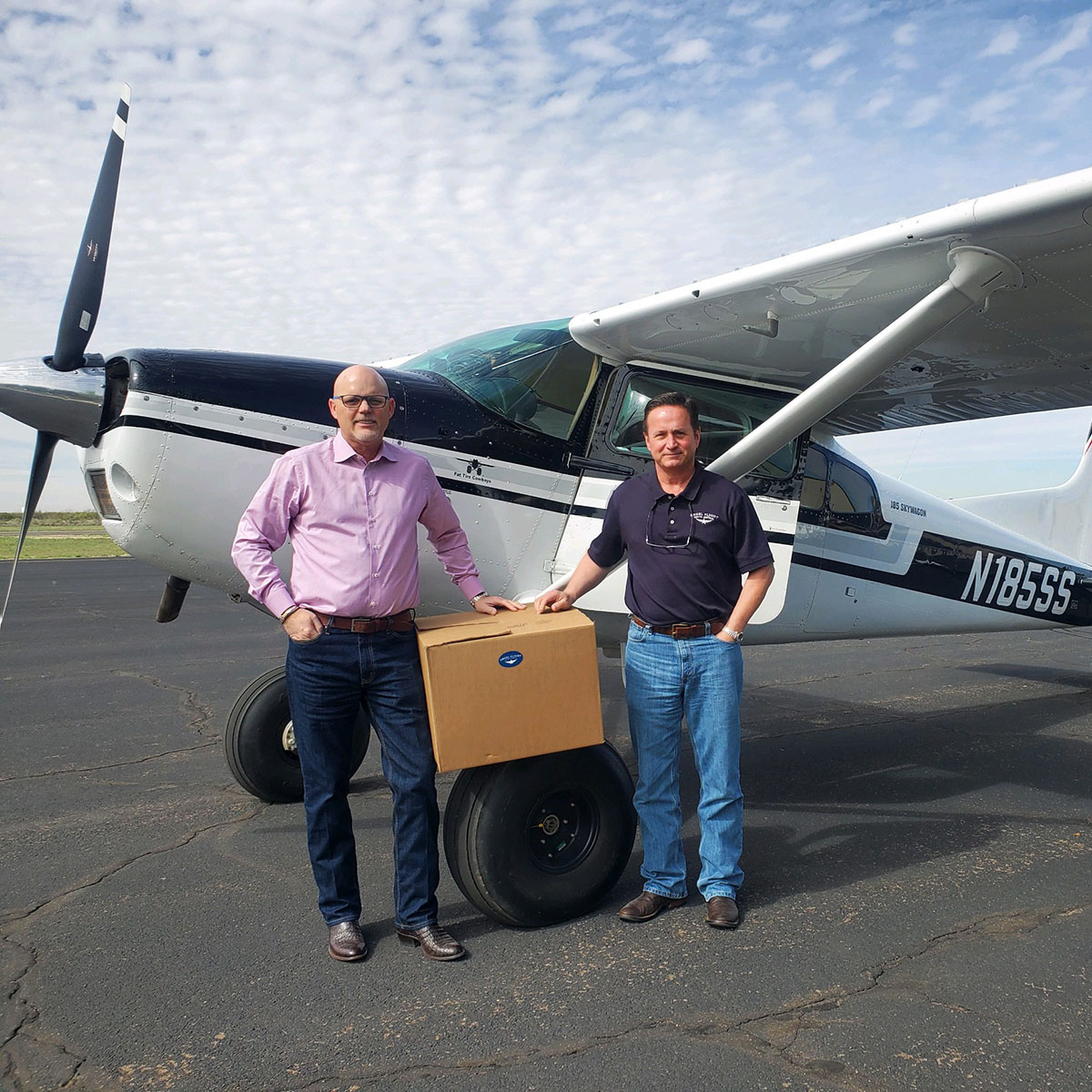Texas Tech University Health Sciences Center, Texas Tech University Join Forces to Develop 3D-Printed Face Masks, Shields to Fight COVID-19

The first batch of face shields was delivered to health care workers at University Medical Center late last week.
This story was originally published and produced by Texas Tech Today.
The first batch of shields was delivered to University Medical Center last week.
A collaborative group of faculty from Texas Tech University and the Texas Tech University Health Sciences Center (TTUHSC) are joining forces to create 3D-printed face shields and face masks for health care workers in hopes of fighting the spread of the coronavirus (COVID-19).
The joint efforts led to the creation of the West Texas 3D COVID-19 Relief Consortium,
a collaborative community involving several departments at TTUHSC, Texas Tech, the
University of Texas-Permian Basin, Odessa College, local businesses, concerned citizens
and aviators.
TTUHSC's Simon Williams, a professor of medical education and cell biology & biochemistry and associate dean for academic affairs in the School of Medicine, said members of the consortium wanted to provide support to the heroic health care workers caring for patients in the current COVID-19 pandemic.
"The West Texas 3D COVID-19 Relief Consortium is using innovative methods to produce
personal protective equipment (PPE), ventilators and ventilator components that will
be distributed to hospitals and health care systems in need throughout West Texas,"
Williams said.
Collaborators come from across both universities, including Texas Tech's Edward E. Whitacre Jr. College of Engineering, Honors College, College of Arts & Sciences, J.T. & Margaret Talkington College of Visual & Performing Arts, College of Architecture, College of Agricultural Sciences & Natural Resources, University Libraries, Innovation Hub at Research Park and Texas Tech Athletics and TTUHSC's J.T. & Margaret Talkington Department of Internal Medicine, Department of Surgery, F. Marie Hall Institute for Rural and Community Health and Libraries.
Williams contacted and worked along with Al Sacco Jr., dean of the College of Engineering. Other efforts were coordinated with Honors College associate dean Aliza Wong, who found an article about two Italian inventors who 3D-printed respirator valves for hospitals in need. She contacted John Carrell, an assistant professor of engineering in the Honors College, to see if Texas Tech could do something similar.
"I also contacted my good friend, Dr. Cynthia Jumper, vice president for health policy and special health initiatives at the TTUHSC, with some of the ideas for valves, face shields and face masks people have shared around the world," Wong said.
Carrell distributed the print file for the individual pieces that comprise the face shields, along with instructions for obtaining the clear shields and assembling them. The School of Theatre & Dance provided elastic materials for the straps and Texas Tech Athletics donated headbands for the face shields.
The more than two dozen 3D printers located across Texas Tech have different output capacities, but as an example, the Library Makerspace is capable of printing five face shields at a time. Considering the necessary cleaning time, it can complete 20 each day.

The first batch of face shields and ventilator splitters were flown to Monahans and Pecos over the weekend.
The team currently has enough material to make 350 face shields, but they hope to produce more than that. The first 32 were delivered to University Medical Center on Thursday (March 26), and some rural partners received shipments Monday (March 30).
Data from the Office of Rural Health will be used to identify needs across West Texas. Planned design improvements include better ways to secure straps and the identification of new sources of straps.
"We also are working on ventilators and respirators – the masks that filter out the virus," Carrell said. "The shields are the easiest to make right now. A little more work is needed on the design and application of the other two, but the goal is to find a design and then make as many as we can."
As part of this effort, researchers in the Center for Emerging Energy Sciences (CEES) have 3D-printed two prototype masks similar to the N-95 masks needed in health care settings. These 3D-printed masks have a similar material in their inhalation chamber to the N-95s and, because they were printed with a new type of filament, they are flexible and fit closer to the wearer's face than previous 3D-printed masks. The prototypes, which fit over the wearer's nose and mouth, are undergoing health professional evaluations at University Medical Center. Once they are cleared for production, CEES can 3D-print 5-6 masks per day. Robert Duncan, professor and President's Distinguished Chair in physics at Texas Tech, is the director of CEES.
In addition, the College of Engineering has printed adaptors for ventilators that
potentially increase the number of patients that can be supported by a single ventilator
in emergency situations. The first trials of these components in Monahans, Texas,
have shown that they fit well and have great potential. Design modifications to allow
regulation of flow to different patients are underway.
Several teams from the consortium also are testing different methods for sterilizing and re-sterilizing PPE using ultraviolet light, heat and hydrogen peroxide. Results are expected this week.
"This is a supplement to existing supplies," said CEES team member Former Maj. Gen. Dr. Annette Sobel, an associate professor in TTUHSC Department of Medical Education and an adjunct professor in the TTUHSC School of Nursing and Graduate School of Biomedical Sciences, as well as the Texas Tech Department of Electrical and Computer Engineering. "It's not going to solve the shortage, but it's an expedient way to fill the gaps."
Related Stories
Celebrating Veterans: TTUHSC’s General Martin Clay’s Legacy of Service and Leadership
From his initial enlistment in the Army National Guard 36 years ago to his leadership in military and civilian health care management roles, Major General Martin Clay’s career has been shaped by adaptability, mission focus and service to others.
Texas Tech University Health Sciences Center School of Nursing Named Best Accelerated Bachelor of Science in Nursing Program in Texas
The TTUHSC School of Nursing Accelerated Bachelor of Science in Nursing (BSN) program has been ranked the No. 1 accelerated nursing program in Texas by RegisteredNursing.org.
TTUHSC Names New Regional Dean for the School of Nursing
Louise Rice, DNP, RN, has been named regional dean of the TTUHSC School of Nursing on the Amarillo campus.
Recent Stories
The Ph.D. Programs that Shape Health Care
The Graduate School of Biomedical Sciences Ph.D. programs at TTUHSC provide the foundation, mentorship and research opportunities you need to pursue groundbreaking work.
Finding Your Future: Master’s Programs at the Graduate School of Biomedical Sciences
At the Graduate School of Biomedical Sciences, you will gain hands-on experience, work alongside expert faculty and collaborate in small, supportive classes that help you thrive.
Making Mental Health a Priority in the New Year
Sarah Mallard Wakefield, M.D., a psychiatrist with Texas Tech Physicians, talks about strategies to combat widespread and growing anxiety.
